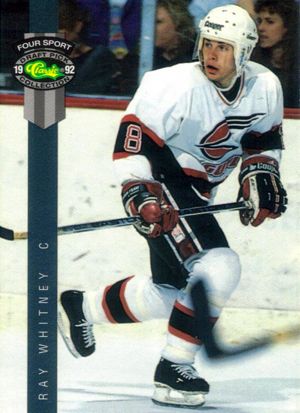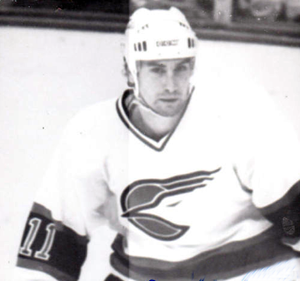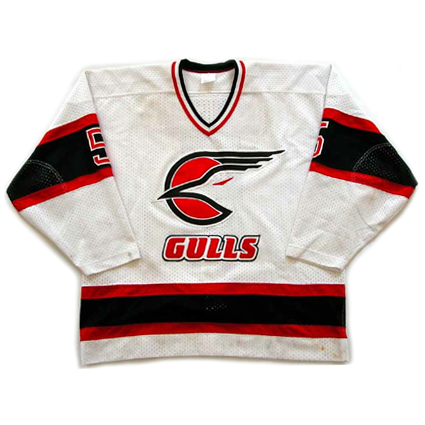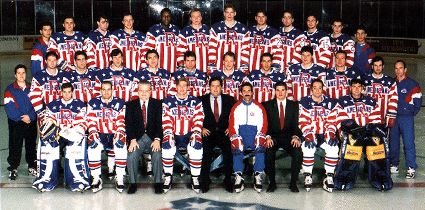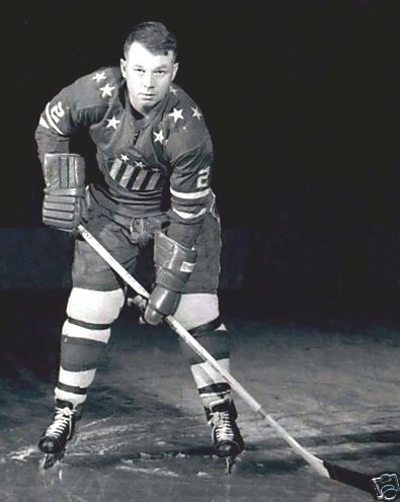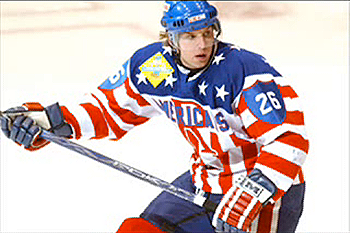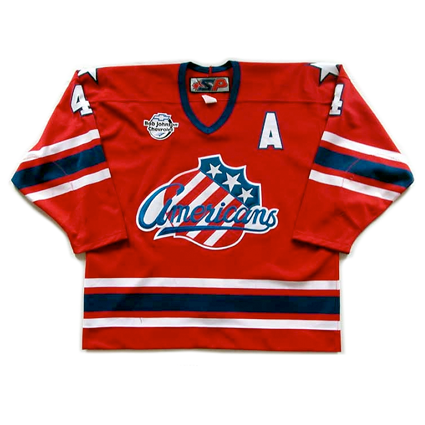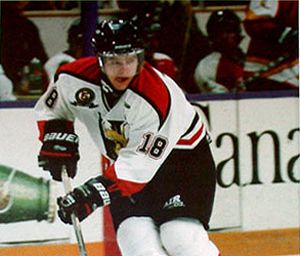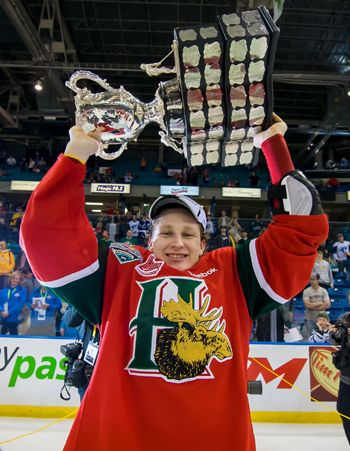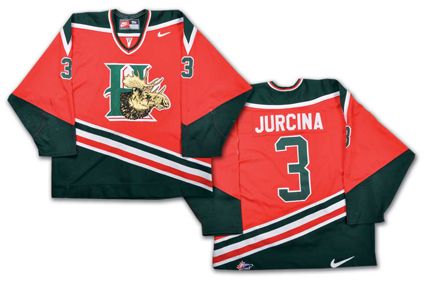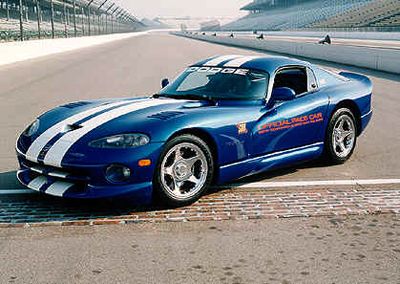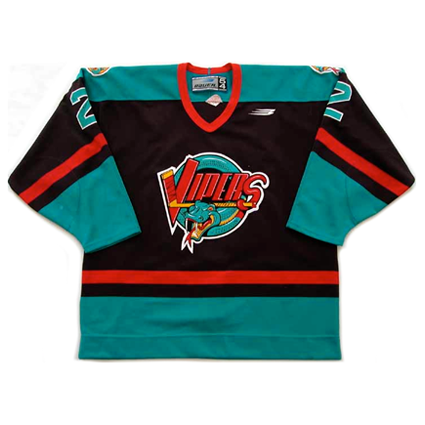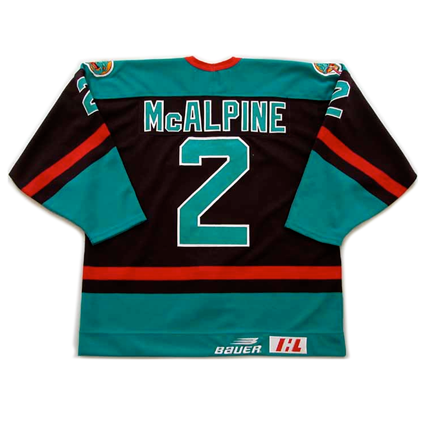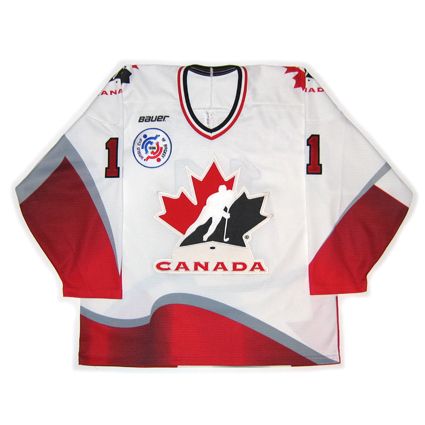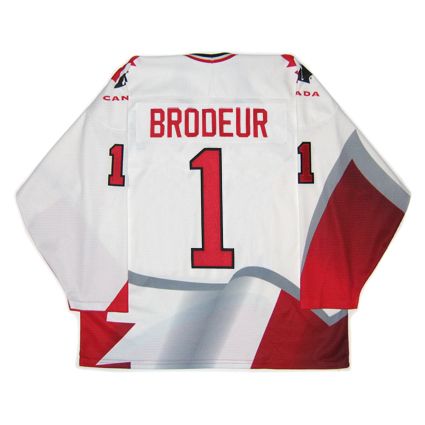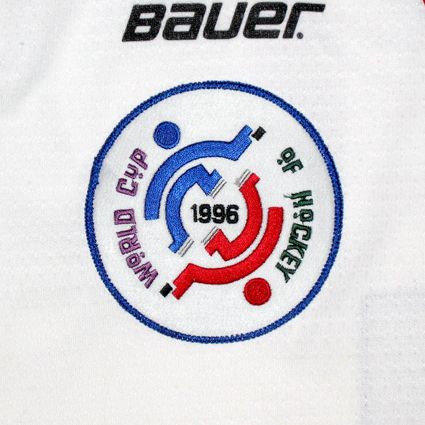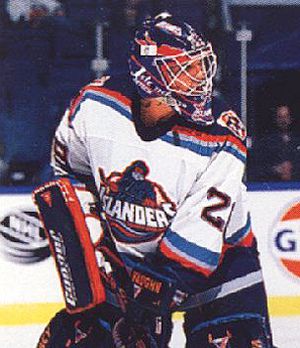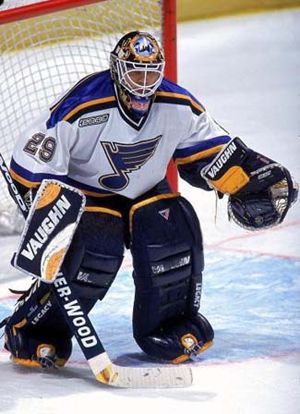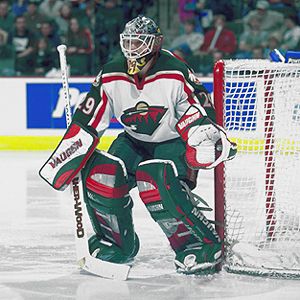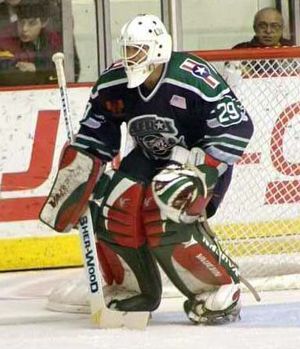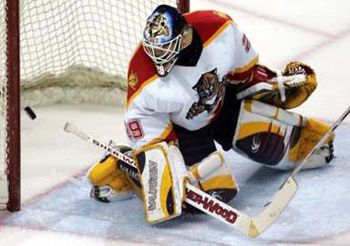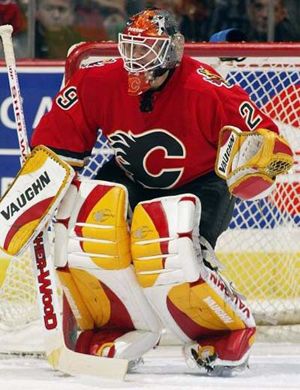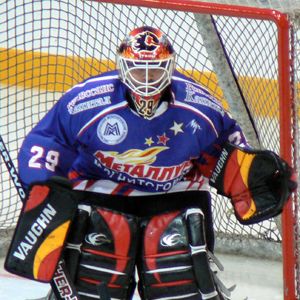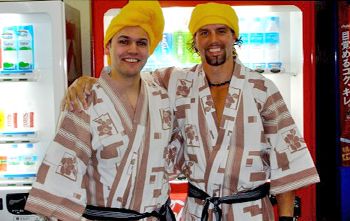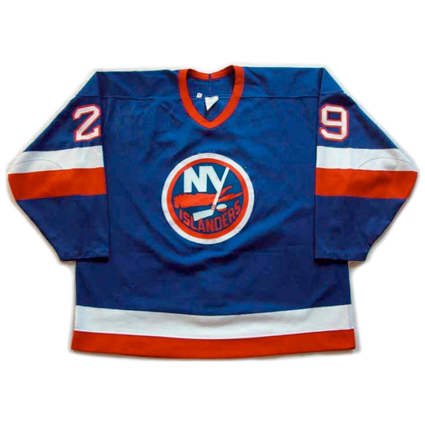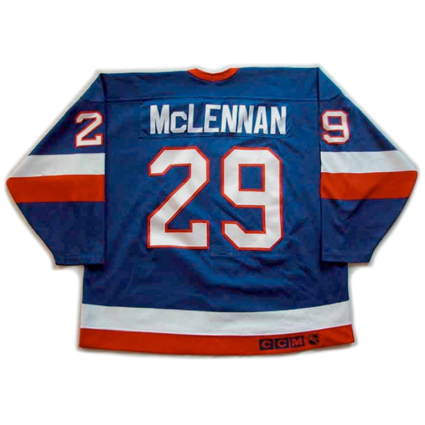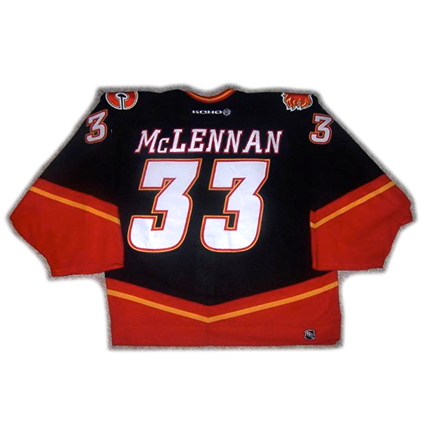Saturday, July 5, 2014
1990-91 San Diego Gulls Peter Dineen Jersey
July by the Numbers crosses the United States for a stop in sunny San Diego, California for jersey #5.
The name San Diego Gulls dates back to the original Gulls franchise, which played in the Western Hockey League from 1966 to 1974. That franchise met it's demise with the arrival of the San Diego Mariners of the World Hockey Association, but the Mariners lasted just three seasons before folding, one of many teams to fall by the wayside in the unstable WHA.
Professional hockey would return to San Diego in 1990 when the International Hockey League would grant the city an expansion franchise, which would revive the name San Diego Gulls.
The team was reasonably competitive their first season with a 30-45-8 record, but missed out on the playoffs.
Russian import Dmitri Kvartalnov arrived for the Gulls second season and helped ignite their offense, which scored 67 goals more than the previous season, led by Kvartalnov's league leading 118 points. His 60 goals also led the IHL and were 16 more than his next closest pursuer.
IHL scoring champion Dmitri Kvartalnov
The Gulls roster also boasted future NHLer Ray Whitney, former New York Ranger Ron Duguay and Wayne Gretzky's brother Keith Gretzky and were led in goal by IHL veteran Rick Knickle.
Ray Whitney
The boost in offense resulted in a reversal of their record, finishing the season 45-28-9, a 31 point improvement.
With Kvartalnov off to join the Boston Bruins, the Gulls no longer had the flashy high scorer they enjoyed the previous season, but they roster was also no longer so top heavy in scoring. Their more balanced attack was led by Daniel Shank's 39 goals and 92 points, which placed him 5th in the league. Former Winnipeg Jet and Buffalo Sabre Scott Arniel was second with 35 goals and 83 points, one of six Gulls with over 70 points, compared to three the year before. Knickle again led the way in goal with 33 wins in 41 appearances as the Gulls soared to a league best 62 wins and 132 points, setting not only IHL records, but professional records as well, tying the 132 points by the 1976-77 Montreal Canadiens and holding the victory record outright until it was tied by the 1995-96 Detroit Red Wings.
The club started the season by going 26 games before losing in regulation for the first time and had winning streaks of 8, 9, 11 and 12 games and never lost more than 2 in a row all season under head coach Rick Dudley. The Gulls were able to load their roster with veteran and experienced players since they were not affiliated with any NHL club eager to have their young prospects developing in the minors. Starting the season with five players who had at least 10 seasons of NHL experience, the club was so dominant that the other IHL owners banded together and passed a rule which required teams to have at least six players with less than three years of professional experience.
As expected, the Gulls swept the Peoria Rivermen and ousted the Kansas City Blades in six to reach the Turner Cup Finals for the only time in their history, but were unceremoniously swept by the Fort Wayne Komets, scoring just 5 goals while giving up a massive 21.
Scott Arneil
The Gulls came back down to earth in 1993-94, winning 42 games while now being coached by former NHLer Harold Snepsts, their fourth coach in four seasons. Lonnie Loach led the club in scoring with 42 goals and 91 points from 74 games, as he also played three games with the Mighty Ducks of Anaheim that season. The Las Vegas Thunder fell in five games to the Gulls, but they in turn were swept by the Atlanta Knights to put an end to their season.
They slipped to a 37-36-8 record in 1995-96 with Hubie McDonough leading the way with 43 goals and 98 points, 6th in the IHL. Allan Bester led the goaltenders with 58 appearances, winning 28, while four other goalies combined to win less than 10. Despite being up 2 games to 1, the Gulls lost the final two games of their best-of-five series, which proved to be the final games for the Gulls.
After finishing third in league attendance in 1992-93 with an average of 7,728, and over 7,100 the following season, the Gulls dropped to 4,660 during their final season as the franchise was then relocated two hours up the coast to Long Beach where they were renamed the Ice Dogs.
Today's featured jersey is a 1990-91 San Diego Gulls Peter Dineen jersey. While the Gulls only lasted five seasons, they left behind a legacy of a striking logo and attractive jerseys of red and black.
Today's video section is some good old IHL hockey from the mid-1990's with fists and mullets as the Gulls and Houston Aeros engage is a battle, which includes current Minnesota Wild head coach Mike Yeo, #8 for the Aeros.
Labels:
San Diego Gulls
Friday, July 4, 2014
2002-03 Rochester Americans Rory Fitzpatrick Jersey
July by the Numbers reaches #4 with the most appropriate jersey possible on America's birthday.
The patriotically named Rochester Americans were founded in 1956, making them the second oldest franchise in the American Hockey League by far, with the third oldest still active team having been founded in 1992.
The Americans have made it to the Calder Cup Finals 16 times, having won the championship six times, first in a run of success that encompassed 1965, 1966 and 1968 as well as an appearance in the finals in 1967, the only team to reach the finals in four consecutive seasons. Other championship titles came in 1983, 1987 and most recently in 1996.
The Calder Cup champion 1995-96 Rochester Americans
Well known players from the early days of the Rochester franchise include goalie Gerry Cheevers, future Islanders coach Al Arbour, future Bruins coach and TV commentator Don Cherry, Jim Pappin and Mike Walton.
Rochester American Don Cherry
After a down period in the late 1960's under the ownership of the Vancouver Canucks, when the team finished last for four straight seasons, local owners purchased the club and installed the dynamic Cherry as coach and general manager which paid dividends as the Americans finished with the best regular season record in 1973-74.
The Americans were later purchased by the owners of the Buffalo Sabres, which naturally led to their becoming the Sabres AHL affiliate, a partnership which lasted from 1979 to 2008, the longest such partnership in AHL history at 29 years which included three championships. Following three seasons apart, circumstances changed which brought the two clubs back together again when new Sabres owner Terry Pegula purchased the Americans in time for the 2011-12 season.
The 2013-14 season for the Americans was a memorable one, as the team hosted the AHL Outdoor Classic and then became the first AHL team in 17 years to participate in the long-running Spengler Cup tournament in Switzerland.
The 2013-14 season for the Americans was a memorable one, as the team hosted the AHL Outdoor Classic and then became the first AHL team in 17 years to participate in the long-running Spengler Cup tournament in Switzerland.
Two numbers have been retired by the team in honor of three players, the #6 for Red Armstrong and #9 for both Dick Gamble and Jody Gage, who broke Gamble's team scoring records.
Jody Gage
Recognizable names to have played for the Americans include Maxim Afingenov, Donald Audette, Martin Biron, Brian Campell, Randy Cunneyworth, Benoit Houge, Ales Kotalik, Uwe Krupp, Mike Milbury, Ryan Miller, Jason Pominville, Darren Puppa, Thomas Vanek and even Grant Fuhr.
Thomas Vanek in the Americans flashy alternate stars and stripes sweater
Today's featured jersey is a 2002-03 Rochester Americans Rory Fitzpatrick jersey. With it's red, white and blue color scheme, patriotic sheild logo and #4, we couldn't think of a more appropriate jersey for the Fourth of July, as it even features sponsorship from a local Chevrolet dealer. All you need while wearing this one would be for your mom to serve you some apple pie!
With it's shield crest, classic Northwestern striping pattern and shoulders decorated with basic stars, this jersey's understated elegance creates a timeless look often left behind in this modern age of excessive piping and gimmicky fonts. A true classic jersey in every sense.
Today's video section begins with Gage scoring his 14th goal of the playoffs in Game 7 of the 1987 Calder Cup Finals, leading to the Americans to their fifth Calder Cup championship.
Here is a further look at Jody Gage, an AHL MVP and member of the AHL Hall of Fame.
Labels:
AHL,
Rochester Americans
Thursday, July 3, 2014
2002-03 Halifax Mooseheads Milan Jurcina Jersey
July by the Numbers crosses the Canadian border for jersey #3 today.
Founded in 1994, the Halifax Mooseheads, the Mooseheads were the idea of Harold MacKay, a regional sales manager for Moosehead Breweries, who felt the time was right to obtain a franchise for the Quebec Major Junior Hockey League, one of three major junior hockey leagues across Canada.
Halifax had teams in the American Hockey League prior to the formation of the Mooseheads, and when the Citadels relocated to Cornwall, the time seemed right to try major junior hockey rather than minor pro hockey. With Moosehead Breweries President and CEO Derek Oland on board with the plan and the vital financial backing, the Mooseheads came to be in time for the 1994-95 QMJHL season despite overcoming the logistical difficulties of all the league's other teams being located exclusively in Quebec at the time.
Players from that first season, in which the Mooseheads qualified for the playoffs, to make an impact in the NHL were goaltender John-Sebastien Giguere and Jody Shelley.
John-Sebastien Giguere
More future NHL players arrived, with Marc Chouinard coming in 1995, Alex Tanguay in 1996 and Ladislav Nagy in 1998.
Alex Tanguay
The Mooseheads were chosen to host the Memorial Cup in 2000. It was an exciting time for the Mooseheads as goaltender and future NHLer Pascal Leclaire, aided by a pair of hat tricks by Ramzi Abid, defeated WHL champions Kootaney Ice and OHL champs the Barrie Colts in their first two games. The success of their hosting the Memorial Cup led to Halifax being chosen as host of the 2003 World Junior Championships.
The clubs best season came in 2002-03 when they had their only 100 point season when a 44-15-10 record gave them 101 points to win the Maritimes Division. The Mooseheads made the QMJHL's playoff championship final for the President's Cup for first time that season, falling in seven games.
They returned to the President's Cup Finals again in 2005, only to run into the buzzsaw that was the Sidney Crosby led Rimouski Oceanic.
Two more Mooseheads to enter the NHL were Jakub Voràček in 2008 and most recently and notably, NHL Rookie of the Year Nathan MacKinnon of the Colorado Avalanche in 2013, who led the Mooseheads to the QMJHL President's Cup as league playoff champions, followed by the 2013 Memorial Cup championship following an outstanding 58-6-3-1 record for a team record 120 points. MacKinnon was both the Memorial Cup leading scorer and Most Valuable Player.
Two more Mooseheads to enter the NHL were Jakub Voràček in 2008 and most recently and notably, NHL Rookie of the Year Nathan MacKinnon of the Colorado Avalanche in 2013, who led the Mooseheads to the QMJHL President's Cup as league playoff champions, followed by the 2013 Memorial Cup championship following an outstanding 58-6-3-1 record for a team record 120 points. MacKinnon was both the Memorial Cup leading scorer and Most Valuable Player.
The club has now retired the numbers of Tanguay (#18), Shelley (#25) and Giguere (#47) and Brandon Benedict is the team's all time leading scorer, with 303 points from 1998 to 2003, 88 points more than second place Brandon Reid and 89 more than Tanguay.
Today's featured jersey is a 2002-03 Halifax Mooseheads Milan Jurcina Jersey. This jersey draws it's influences from the Pittsburgh Penguins and their innovative pointed shoulder yoke and the Mighty Ducks of Anaheim's groundbreaking diagonal waist striping in an attractive forest green and red color palette.
Our video section today consists of highlights of the Mooseheads 2012-13 season, which concluded with their capturing the 2013 Memorial Cup.
Labels:
Halifax Mooseheads,
QMJHL
Wednesday, July 2, 2014
1999-00 Detroit Vipers Chris McAlpine Jersey
July by the Numbers continues onto jersey #2.
Back in 1969, the Salt Lake Golden Eagles were founded and played in both the WHL and CHL prior to moving to the IHL in 1984. The team was sold in 1994 to Palace Sports and Entertainment, who owned the Detroit Pistons of the NBA, who relocated the club to the Detroit area to play in The Palace of Auburn Hills in time for the 1994-95 season.
A sponsorship agreement with the Chrysler Corporation led to the franchise being named the Detroit Vipers after Chrysler's Dodge Viper model.
The Vipers were an immediate hit at the box office, breaking the IHL attendance record in their first season with an average of 17,000 per game, something a number of NHL clubs would love to duplicate.
Led by Daniel Shank's 44 goals and Peter Ciavaglia's 81 points, the Vipers won the league's Northern Division, but were ousted in round 1 of the playoffs.
They again led the league in attendance in 1995-96 when Lonnie Loach led the team with 86 points. They defeated Indianapolis to advance to the second round of the playoffs before bowing out.
1996-97 saw the arrival of Russian Sergei Samsonov and IHL All-Star Stan Drulia to support Ciavaglia and Todd Simon, who led the team with 72 points each. Drulia followed with 71 and Samsonov was named Rookie of the Year following his 64 point campaign. The Vipers won the North Division with a league-best 122 points and entered the post season as favorites for the title.
Goaltender Rich Parent, who brought a 31-13-4 mark into the playoffs, guided the team past the Michigan K-Wings, the Quebec Rafales and the Cleveland Lumberjacks to reach the Turner Cup Finals against the Long Beach Ice Dogs. The Vipers won Game 1 at home 5-3, but lost Game 2 3-0. They took Games 3 and 4 in Long Beach, but the Ice Dogs stayed alive by winning Game 5 at home 2-1. Back on home ice for Game 6, Detroit clinched the championship with a 2-0 blanking of the Ice Dogs, led by Ciavaglia's 33 playoff points in 21 games.
1997-98 will be remembered for a one off appearance by the nearly 70 year old Gordie Howe, which made him the only player to appear in a professional game in six different decades.
The Vipers again won their division and were led by Dan Kesa and Steve Walker in points with 77 and 76 respectively. Jeff Reese took the bulk of the goaltending duties and in 46 games went 27-9-8. The team returned to the finals again, but despite taking a 3 games to 2 lead, lost the final two games to the Chicago Wolves.
Their success on the ice continued in 1998-99 when they scored 100 points in the standings for the fifth straight season, the first professional team to do so in their first five seasons. Drulia led the team with 75 points. The playoffs saw them reach the conference finals before losing in overtime of Game 7.
The Palace Sports and Entertainment organization purchased the Tampa Bay Lightning of the NHL in 1999, which had a tremendous adverse effect on the Vipers, where were now the Lightning's top minor league affiliate. The struggling Lightning called up many of the Vipers better players throughout the season, plummeting the once strong and stable Vipers to the depths of the league, where they finished last with 52 points, 26 less than the second-worst team. Walker's 46 points led the club, his low total a reflection of the state of the franchise.
2000-01 was a repeat of the previous season, as Detroit again managed only 52 points in the standings, a distant last in the league. Martin Cibak was the leading scorer with just 38 points.
The Vipers were now last in league attendance and the IHL was in deep trouble as a league as well. Only four teams had NHL affiliations, travel costs had risen as the league expanded and finally the league folded after the 2000-01 season after 56 years of operation. Six of the 11 remaining IHL clubs survived by joining the AHL, but the Vipers were not included as one of the six and ceased operations on June 4, 2001 when the IHL ended for good.
The story of the Detroit Vipers is a melancholy one, flying high in attendance and in the standings, setting records for success on both fronts and winning a championship, followed by a complete collapse both on the ice and at the box office in two short seasons, flaming out like a shooting star.
Today's featured jersey is a 1999-00 Detroit Vipers Chris McAlpine jersey. While the Vipers were a success on the ice for the majority of their existence, their jerseys were not.
Unfortunately the team relocated to Detroit at a time when the color palette of sports was changing due to the commerical success of the San Jose Sharks teal jerseys, first introduced in 1991.
The Vipers brash color scheme included the trendy 90's colors of dark eggplant and aqua for their jerseys, with garish red striping. Add in the overly complicated Vipers logo and you are left with one seriously ugly eyesore of a jersey that was neither classy, timeless or attractive in any way. And you should see the font they originally used in 1994-95 for the numbers. Terrible! Fortunately Gordie Howe wore the home white version of the jersey, which was somewhat less appalling.
Today's video begins with a look at the madness and mayhem of minor league hockey. Perhaps all the hard hits and fights were a result being angry about having to wear those horrible colored jerseys.
This next video was produced by the team and given to season ticket holders which celebrates their Turner Cup Championship in 1997.
Labels:
Detroit Vipers,
IHL
Tuesday, July 1, 2014
1996 Team Canada Martin Brodeur Jersey
With the lack of significant historical events in hockey history in July, we have decided to reprise a little different approach to the heart of summer. Every day in July we are going to feature a jersey whose number on the back matches the current date.
Simple, eh?
It's a chance for us to showcase some jerseys that frankly aren't related to a Stanley Cup victory, milestone goal or a player's birthday. We call it "July by the Numbers".
So, for July 1st, we begin at the beginning and kick things off with a jersey that carries the #1, and you just knew it was going to be a goaltender, didn't you?
July 1st is "Canada Day", which celebrates the enactment in 1867 of the British North America Act which united New Brunswick, Nova Scotia and the Province of Canada, which was comprised of what would be divided into Ontario and Quebec as part of the process, into a single country.
On June 20, 1868, the Governor General issued a proclamation asking for Canadians to celebrate the anniversary of the confederation. It became an official holiday in 1879 and was originally called "Dominion Day". As most residents considered themselves to still be primarily British, the holiday was not observed with any official celebration until 1917 and not widely observed as a uniquely Canadian holiday until as recently as 1958 when the government began to organize Dominion Day celebrations with a military parade in full dress uniform, called "Trooping the Colour", on Parliament Hill, followed by a band concert and fireworks display.
Dominion Day reached an important milestone in 1967 with the countries centennial, by which time Canadians became more proud of their independence from Britain. Televised concerts and other events from the nation's capital of Ottawa raised the profile of the event, while the government began to promote Dominion Day beyond the capital by giving grants to cities across the country to help fund local events.
While many people had began calling July 1st "Canada Day" informally, the new name was officially adopted in 1982. Today communities across Canada will celebrate with festivities such as parades, carnivals, picnics, air shows, concerts and fireworks, with the organized events on Parliament Hill the main event, with Queen Elizabeth sometimes in attendance, as she will be today in 2010, her first appearance since 1997.
On the jersey front, while the hockey season is completed by July 1st, the Toronto Blue Jays baseball club annually wears a special red jersey on Canada Day.
Today's featured jersey is a 1996 Canada National Team Martin Brodeur jersey, worn during the inaugural 1996 World Cup of Hockey. While you may be more accustomed to seeing Brodeur wear his more familiar #30, veteran Bill Randford was also on the Canadian roster for the tournament and wore the #30 based on his greater seniority.
This "waving flag" style jersey is one of the most attractive national team jerseys and features the larger 4 inch size 1996 World Cup of Hockey patch used by the teams that wore Bauer jerseys. Only Canada wore the patch on their chest, while all the other teams in the tournament wore their patches on the left sleeve.
Our video section begins with a salute to canada from Flippy Cat.
We know you want to be a Canadian. After watching this, you will agree too.
To sum up what it is to be Canadian, we present Joe.
No mention of Canada would seem complete without the man who penned "The Good Old Hockey Game", Stompin' Tom Connors.
Labels:
Canada
Monday, June 30, 2014
1993-94 New York Islanders Jamie McLennan Jersey
No other path through a hockey career can match that of goaltender Jamie McLennan, born on this date in 1971, who made stops in Canada, the United States, England, Russia and Japan with a stop at death's door for good measure!
His journey though the world of hockey began in 1988-89 with first the Spokane Chiefs followed by a move to the Lethbridge Hurricanes of the WHL. He returned to Lethbridge the following season and posted a stellar 20-4-2 record. He became the #1 goaltender for the Hurricanes in 1990-91, going 32-18-4 which led to his being taken 48th overall by the New York Islanders at the 1991 NHL Entry Draft, the second goaltender selected in the draft.
He began his climb to the NHL with the Richmond Renegades of the East Coast Hockey League in 1991-92 before a promotion to to the Capital District Islanders of the American Hockey League. After spending a second season with Capital District in eastern New York in 1992-93, McLennan trekked west to compete for the Salt Lake Golden Eagles of the International Hockey League before making his NHL debut with a 6-2 win over the Calgary Flames on January 7, 1994. By playing in the NHL, McLennan had now competed in five different leagues in four seasons.
McLennan spent the next season divided between the Islanders and their top AHL affiliate, which was the Denver Grizzlies in 1994-95. In 1995-96, he tended goal for a trio of clubs, the Islanders of the NHL for 13 games, the Grizzlies, who had relocated to Salt Lake City and were now known as the Utah Grizzlies for 14 games as well as playing the majority of his season with the Worcester Ice Cats of the AHL in 22 games, making in three different leagues in one season for the hockey vagabond.
McLennan had the misfortune of having to wear
the "fisherman" jersey while on Long Island
the "fisherman" jersey while on Long Island
At the conclusion of the season, McLennan drove from Salt Lake City to Lethbridge, Alberta on his way home to Edmonton. While in Lethbridge visiting relatives, he became ill with what he believed was the flu. After feeling ill for some time and his symptoms becoming worse, he went to a hospital now believing he was suffering from food poisoning after a night of fever and vomiting.
Once at the hospital he was diagnosed with bacterial meningitis and went into a coma, but not until a doctor noticed the black spots on his arms and legs and declared "We better call your parents. You might not make it." Luckily enough, he had arrived at the hospital early enough to receive proper treatment, but not before spending the next five days in a delirious state due to the inflammation of the membrane around his brain and spinal cord.
He still required three weeks in intensive care, ended up losing 30 pounds and needed to learn how to walk again following the ordeal.
Due to his medical setback, McLennan spent the entire 1996-97 season with the Ice Cats returning to form as a professional hockey player after signing a contract with the St. Louis Blues organization.
McLennan returned to the NHL with the Blues for the 1997-98 season, playing in 30 games and finishing with a 16-8-2 mark.
His brush with death and subsequent return to the NHL earned McLennan the 1998 Masterton Trophy for perseverance and dedication to hockey.
He played two more seasons with St. Louis, but saw his number of games decline from 30 and 33 down to 19 which made him available in the 2000 Expansion Draft where he was selected by the new Minnesota Wild, where he saw plenty of ice time, but dreadful goal support whenever he started, far less than teammate Manny Fernandez, doomed him to a 5-23-9 record despite a 2.64 goals against average.
After the Wild signed Dwayne Roloson for 2001-02, McLennan was relegated to the Houston Aeros of the AHL for the entire season.
At the following NHL Draft, McLennan was dealt to the Calgary Flames as a backup to Roman Turek for 2002-03 and found himself a part of a crowded crease in 2003-04 with the arrival of Miikka Kiprusoff before being dealt late in the season to the New York Rangers with whom he played just four games during the final month of the season.
At the following NHL Draft, McLennan was dealt to the Calgary Flames as a backup to Roman Turek for 2002-03 and found himself a part of a crowded crease in 2003-04 with the arrival of Miikka Kiprusoff before being dealt late in the season to the New York Rangers with whom he played just four games during the final month of the season.
During the summer of 2004, McLennan was signed by the Florida Panthers as a free agent, but remained mostly inactive during the NHL lockout of 2004-05, he signed with the Guildford Flames of the British second division for three regular season games and seven playoff contests.
With the labor issues now settled, he made his Panthers debut during the 2005-06 season, but was limited to just 17 games behind workhorse Roberto Luongo.
With his contract now expired, McLennan returned to Calgary for the 2006-07 season to again back up Kiprusoff, now himself an entrenched #1 as well as another workhorse, which saw McLennan limited to a mere nine games. He did make one infamous playoff appearance, during which he came into the game in relief of Kiprusoff, and lasted a mere 18 seconds before slashing Detroit forward Johan Franzen, which earned him a game misconduct and a match penalty and a later five game suspension.
To start the 2007-08 season, McLennan played five weeks for Metallurg Magnitogorsk of the Russian Superleague.
McLennan while with Metallurg Magnitogorsk - note the Calgary Flames mask
McLennan later signed in late November with the Japanese Nippon Paper Cranes of the Asia Hockey League, his seventh different league as a professional, after he and former Blues teammate Tyson Nash were recruited by a friend already on the roster, giving them a unique opportunity to continue playing hockey and experiencing the Japanese culture for an extended period of time. To read more about McLennan's experiences in Japan, check out his blog at The Hockey News here.
Jamie McLennan and Tyson Nash experiencing Japan
It was to be his final season as a professional, as he announced his retirement following the season, bringing to an end a career which saw him play in 254 NHL games and finishing with a record of 80-109-36 along with a career goals against average of 2.68.
Today's featured jersey is a 1993-94 New York Islanders Jamie McLennan jersey worn during McLennan's rookie season. While the basic basic blue Islanders jersey underwent some detail changes since it's introduction in 1972 up until it was first discontinued in 1995 in favor of the controversial "Fisherman" style, the fans demanded it's return, which came in an updated version of the original in 1998 which used a considerably darker shade of blue.
With the introduction of the Reebok Edge jerseys in 2007, the Islanders began to stray too far from the originals once more, which resulted in a new lighter blue alternate jersey being introduced in 2008 which replicated their 1973 jersey as much as possible with the Reebok Edge cut. It was so well received that it became the primary home jersey just two years later and a new white version was created to complete the set.
Bonus Jersey: Today's bonus jersey is a 2002-03 Calgary Flames Jamie McLennan jersey. This alternate debuted in 1998 and featured a flaming horse head logo in honor of the famous Calgary Stampede rodeo. After two seasons of use this style was promoted to being the Flames primary road jersey.
Unusually, when the NHL declared that dark jerseys would now be the primary home jerseys beginning in 2003, the Flames introduced a new red primary home red, yet the black jersey survived by once again returning to alternate status for three additional seasons. There has never been another instance of an alternate jersey being promoted to primary status and then returned to duty as an alternate once again, as they are generally retired when replaced by a brand new style.
For a looking into the wacky personality of the man called "Noodles", check out this funny video poking fun at his lack of playing time while backing up Luongo while with the Panthers.
Here is McLennan is interviewed in two parts, which includes him talking about his battle with meningitis.
Labels:
McLennan Jamie,
New York Islanders
Subscribe to:
Comments (Atom)


